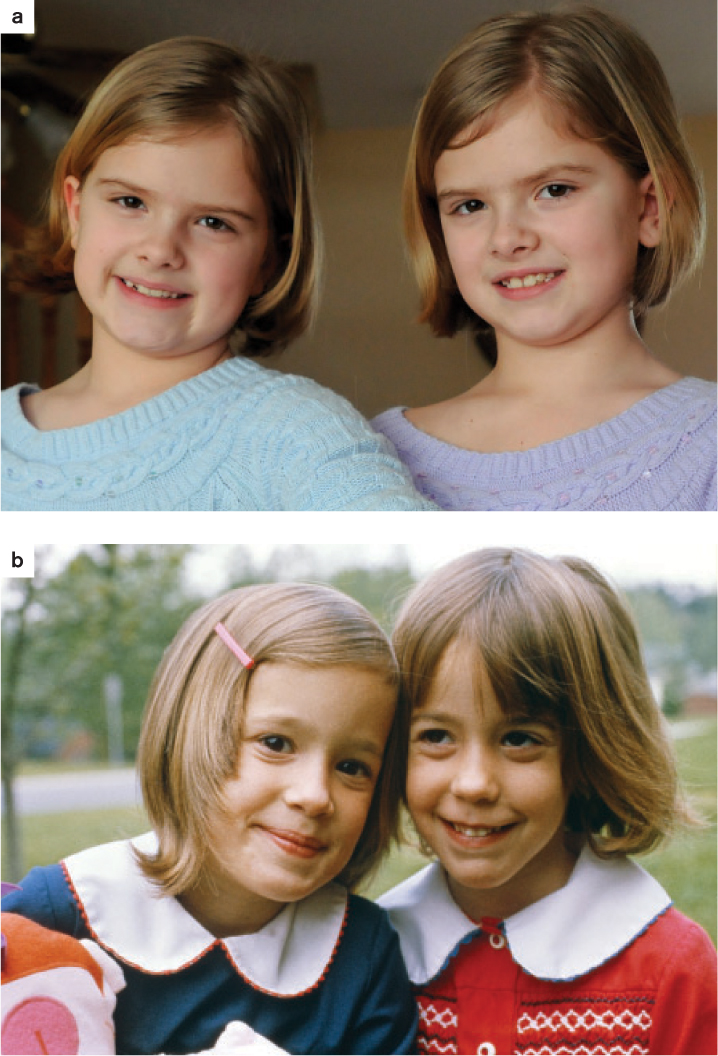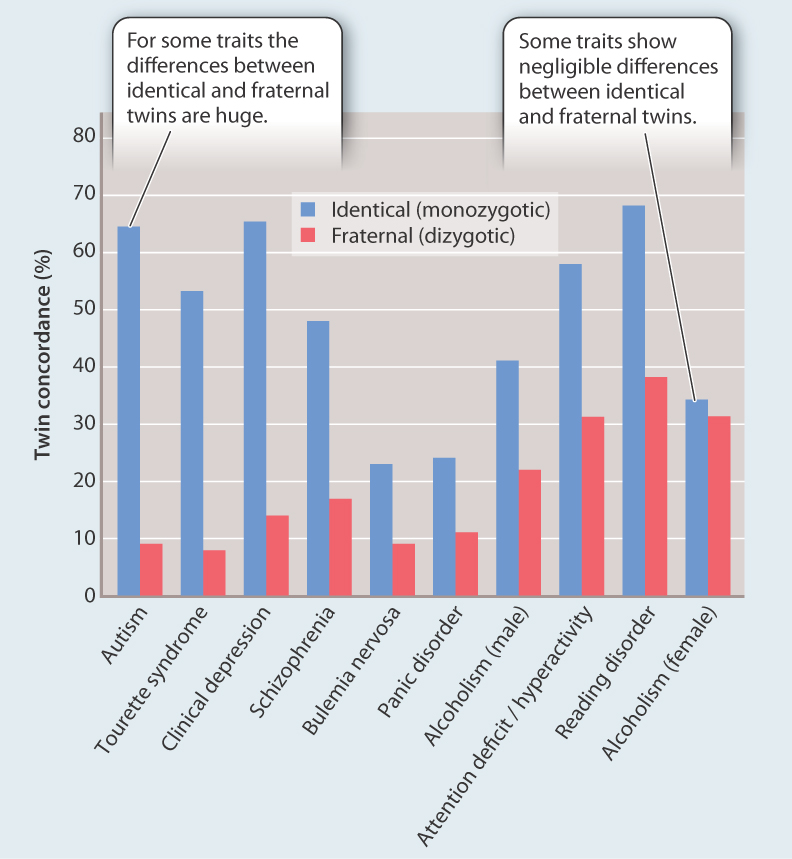18.3 TWIN STUDIES
Galton pioneered studies of twins as a way to separate the effects of genotype and environment in phenotype differences among individuals. Depending on whether they arise from one or two egg cells, twins can be identical (monozygotic twins) or fraternal (dizygotic twins). Identical twins arise from a single fertilized egg (the zygote), which, after several rounds of cell division, separates into two distinct but genetically identical embryos. Strikingly similar in overall appearance (Fig. 18.10a), identical twins have stimulated the imagination since antiquity, inspiring stories by the Roman playwright Plautus, William Shakespeare (himself the father of twins), Alexander Dumas, Mark Twain, and many others.

In contrast, fraternal twins result when two separate eggs, produced by a double ovulation, are fertilized by two different sperm. Whereas identical twins are genetically identical, fraternal twins are only as closely related as any other pair of siblings (Fig. 18.10b).
18.3.1 Identical twins share the same genotype.
The utility of twins in the study of complex traits derives from the genetic identity of identical twins. Whereas differences between fraternal twins with regard to any trait may arise because of genetic or environmental factors (or genotype-by-environment interactions), differences between identical twins must be due only to environmental factors because the twins are genetically identical. Consequently, if variation in a trait has an important genetic component, then identical twins will be more similar to each other than fraternal twins are similar to each other. But if the genetic contribution to variation is negligible, then identical twins will not be more similar to each other than fraternal twins are to each other.
One criticism that arises in twin studies—and it is a serious one—is that the environment of identical twins is often more similar than that of fraternal twins. Within the uterus, identical twins frequently share the same embryonic membranes and placenta, whereas fraternal twins rarely do. After birth, the striking resemblance in facial appearance, body shape, and other features between identical twins often leads their parents, teachers, and friends to treat them more similarly than if they were fraternal twins. Resemblances between identical twins due to similarities in their environments will mistakenly be attributed to their genetic identity. This difficulty can be minimized in part by studying identical twins who were separated from each other shortly after birth and reared in different environments, but identical twins reared apart are rare.
Ongoing studies at the University of Minnesota begun about 30 years ago united dozens of twins reared apart and found some astonishing coincidences—separated twins wearing the same color of clothes, sporting the same number of rings on the same fingers, giving their dogs the same name, sending their friends the same birthday cards. But some skepticism of such coincidences may be in order. If you sit down with anybody—even a complete stranger—of your age, sex, ethnic group, and socioeconomic background and compare your life histories, likes, dislikes, hobbies, sports, and personality traits, the two of you are likely to discover many quirky similarities. This observation does not invalidate twin studies but suggests that they should be interpreted with caution.
18.3.2 Twin studies help separate the effects of genes and environment in differences among individuals.
For complex traits, such as depression or diabetes, the extent to which twins are alike is measured according to the concordance of the trait, which is defined as the percentage of cases in which both members of a pair of twins show the trait when it is known that at least one member shows it. The relative importance of genetic and environmental factors in causing differences in phenotype can be estimated by comparing the concordance of identical and fraternal twins. A significantly higher concordance rate for a given trait for identical twins compared to that for fraternal twins suggests that the trait has a strong genetic component. Similar concordance rates for identical and fraternal twins suggest that the genetic component is less important.
In the study of concordance, twin pairs in which neither member is affected contribute no information, and these twin pairs must be removed from the analysis. The concordance is based solely on twin pairs in which one or both members express the trait. To take a concrete example, let us symbolize each member of a twin pair as a closed square (▪) if the member shows the trait and as an open square (□) if the member does not show the trait. Then, in any sample of identical twins, there are three possibilities, illustrated with data for adult-onset diabetes:
- ■■ 36 identical twin pairs, both showing adult-onset diabetes
- ■□ 40 identical twin pairs, only one showing adult-onset diabetes
- □□ 336 identical twin pairs, neither showing adult-onset diabetes
In this example, the 336 twin pairs who do not show the trait provide no information. The concordance is based only on the first two types of twin pairs, among which in 36 pairs both members show the trait and in 40 pairs only one shows the trait. In this case the concordance among identical twins is 36/(36 + 40) = 47%. Among fraternal twins, by contrast, the concordance for adult-onset diabetes is only 10%. The difference in concordance between identical and fraternal twins (47% for identical twins versus 10% for fraternal twins) implies that differences in the risk of adult-onset diabetes have an important genetic component. Furthermore, the observation that the concordance for identical twins is much less than 100% implies that environmental factors (which we now know to include diet and exercise) are also important in the risk of adult-onset diabetes.
Table 18.1 shows identical and fraternal twin concordance rates for a number of other disorders. Just as with diabetes, the marked difference in concordance rates between identical and fraternal twins for high blood pressure, asthma, rheumatoid arthritis, and epilepsy suggests that all these disorders have an important genetic component. In addition, the fact that the concordance is not 100% even for identical twins implies that both genes and environment—“nature” and “nurture”—play important roles in the differences in risk among people.
| Table 18.1: Concordance Rates for Identical and Fraternal Twins for Several Diseases | ||
|---|---|---|
| DISORDER | CONCORDANCE IN IDENTICAL TWINS (%) | CONCORDANCE IN FRATERNAL TWINS (%) |
| High blood pressure | 25 | 7 |
| Asthma | 47 | 24 |
| Rheumatoid arthritis | 34 | 7 |
| Epilepsy | 37 | 10 |
| Cancer at any site | 16 | 13 |
| Acute infection leading to death | 8 | 9 |
Contrast these results with the data for cancer and death from acute infection in Table 18.1. Note that in these cases the concordance rates for identical twins are very similar to those for fraternal twins—there is no significant genetic component to variation in risk, at least insofar as can be determined from twin studies. For these conditions, the environment plays an important role. (There are some inherited cancer syndromes, but these are so rare relative to the overall incidence of cancer that they have a negligible effect on twin concordance.)
Fig. 18.11 shows the identical and fraternal concordance rates for a number of common behavioral disorders. For some, such as schizophrenia, depression, and autism, the difference between identical and fraternal twins is very great, again implying an important role for genetic factors. For other traits, such as alcoholism in females, the difference is negligible, suggesting an important role for environmental and social factors. This example also illustrates that complex traits can have quite different risk factors and outcomes in different sexes.
FIG. 18.11What is the relative importance of genes and the environment for complex traits?
BACKGROUND Twin studies remain important for assessing the relative importance of “nature” (genotype) and “nurture” (environment) in determining variation among individuals for complex traits. The idea of using twins to distinguish nature from nurture is usually attributed to Francis Galton because of an article he wrote about twins in 1875. In fact, the modern twin study does not trace to Galton but to Curtis Merriman in the United States and Hermann Siemens in Germany, who independently hit upon the idea in 1924. In Galton’s time, it was not even known that there are genetically two kinds of twins.
EXPERIMENT The rationale of a twin study is to compare identical twins with same-sex fraternal twins. In principle, identical twins differ only because of environment, whereas fraternal twins differ because of genotype as well as environment. The extent to which fraternal twins differ more from each other than identical twins differ from each other measures the effects of genotype. Some twin studies focus on twins reared apart in order to compensate for shared environmental influences that may be stronger for identical twins than for fraternal twins.
RESULTS The bar graph shows the results of typical twin studies for various traits. The concordance between twins is the fraction of twin pairs in which both twins show the trait among all those pairs in which at least one twin shows the trait. Roughly speaking, the difference in the concordance between identical twins and fraternal twins is a measure of the relative importance of genotype. In the data shown here, for example, autism and clinical depression both show strong genetic influences, whereas female alcoholism shows almost no genetic influence.

CONCLUSION The examples shown here indicate very large differences in the importance of genotype versus environment among complex traits. These results are typical of most complex traits.
FOLLOW-UP WORK Twin studies must be interpreted in light of other studies comparing complex traits among individuals with various degrees of genetic relatedness. On the whole, twin studies of complex traits have yielded results that are consistent with other available evidence.
SOURCES Rende, R. D., R. Plomin, S. G. Vandenberg. 1990. “Who Discovered the Twin Method?” Behavior Genetics 20:277–285; McGue, M., and T. J. Bouchard, Jr. 1998. “Genetic and Environmental Influences on Human Behavioral Differences.” Annual Review of Neuroscience 21:1–24.